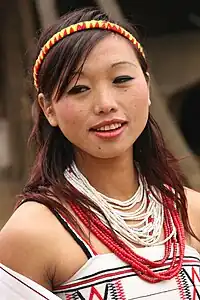Lyngngam language
Lyngngam is an Austroasiatic language of Northeast India closely related to Khasi language. Once listed as a dialect of Khasi, Lyngngam has in recent literature been classified as a distinct language. Lyngngam speakers have food and dress similar to the neighboring Garo people.
| Lyngngam | |
|---|---|
| Lyngam | |
| Native to | India |
| Region | Meghalaya, Assam |
Native speakers | 11,586 (2011 census)[1] |
Austroasiatic
| |
| Language codes | |
| ISO 639-3 | lyg |
| Glottolog | lyng1241 |
Phonology
Consonant inventory
The following table lists the consonants attested in Lyngngam.[2]
Bilabial Alveolar Palatal Velar Glottal Nasal /m/ /n/ /ɲ/ /ŋ/ Stop voiceless /p/ /t/ /c/ /k/ /ʔ/ aspirated /pʰ/ /tʰ/ /cʰ/ /kʰ/ voiced /b/ /d/ /ɟ/ /ɡ/ Voiceless fricative /s/ /h/ Liquid /l, r/ Glide /w/ /j/
The main difference with the Khasi language is that Lyngngam does not possess the voiced aspirated series. Furthermore, Lyngngam does not have the phoneme /ç/. Words which have /ç/ in Khasi typically have /c/ or /s/ in Lyngngam,[3] as in the following pairs of cognates:
Lyngngam Khasi meaning cʔeŋ çʔeŋ bone cɨppʰeu çipʰeu 10 sɲjək çɲiuʔ hair snaːr çnjaʔ chisel
Vowel inventory
The following table lists the vowel inventory of the language.[2] The only vowels showing a length distinction are /i/ and /a/, in contradistinction to Khasi, where length is distinctive for all vowels.
Words with diphthongs in Khasi have monophthongs in Lyngngam,[3] as in the following pairs of cognates:
Lyngngam Khasi meaning bni bnaːi month ksu ksəu dog mot miet night
References
- "Statement 1: Abstract of speakers' strength of languages and mother tongues - 2011". www.censusindia.gov.in. Office of the Registrar General & Census Commissioner, India. Retrieved 2018-07-07.
- Nagaraja 1996, sect. 1
- Nagaraja 1996, sect. 2
- Nagaraja, K.S. (1996). "The status of Lyngngam" (PDF). Mon–Khmer Studies. 26: 37–50. Retrieved 9 March 2014.
